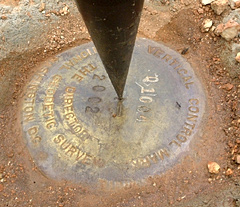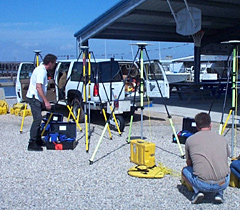|
|

 |
|
|
A dramatization of construction of a bridge across a waterway without using geodesy. Geodesy is the branch of mathematics that deals with the shape and area of the Earth.
|
 |
|
Without a good foundation, a building will collapse. Our transportation infrastructure is the same way. The location and placement of roads must be predetermined so that traffic runs smoothly. When building a road or bridge over water, construction teams have to make sure that the two sections of the bridge will meet at the same point. If they don’t, the bridge will be unusable.
National Spatial Reference System
 |
|
|
An example of the kind of mark NGS
sets.
|
 |
|
NOAA’s National Geodetic Survey (NGS) provides the foundation needed for these kinds of projects. NGS and its predecessor agencies have set permanent survey marks throughout the United States. Each survey mark has an exact horizontal and vertical position, defined by latitude, longitude, and height coordinates, in relation to the surface and shape of the Earth. NGS connects these marks together in a network called the National Spatial Reference System (NSRS). This network is the federal standard and foundation for all positioning and navigation activities.
NGS is exploring how to use more efficient methods to measure the vertical points in the NSRS. By knowing elevations or heights, it is possible to measure how fast land is sinking or the vertical distance between a ship’s bottom and the channel floor. Height Modernization is a program within NGS that provides accurate height information needed to develop and expand the vertical portion of the NSRS.
(top)
 |
|
|
Traditional surveying.
|
 |
|
Global Positioning System
Until very recently, NGS relied on traditional line-of-sight survey measurements to position permanent marks. This process, which requires field crews to measure distances between marks, was time consuming and expensive. However, with the advent of the Global Positioning System (GPS) in the 1980s, these methods drastically changed. By using GPS, the Height Modernization Program can accurately and quickly collect data on elevation.
 |
|
|
Setting up GPS equipment.
|
 |
|
The use of GPS has progressed in two stages. Initially, GPS was much more accurate in determining horizontal coordinates than vertical heights due to a number of technical factors. For the past several years, however, the National Geodetic Survey, in cooperation with the GPS community, has developed standards, specifications, and techniques that enable GPS to attain the accuracy levels required for most applications using height information.
These height modernization techniques are not yet commonly known or practiced by the private-sector surveying community, because to introduce them on a widespread basis requires a major technology-transfer effort. In addition, the existing geodetic reference framework that supports height measurements must be updated to efficiently support the use of GPS to determine accurate height measurements without additional advancements.
(top)
 |
|
|
Height modernization is needed to help ships navigate under bridges. Photo credit: 111th Aerial Photography Squadron 2002
|
 |
|
Height Modernization Studies
In 1998, the U.S. Congress directed NGS to conduct a National Height Modernization Study (U.S. Dept. of Commerce, 1998) to determine the effectiveness of height modernization in two states, California and North Carolina, and its potential benefits to the nation. In 2001, Congress requested additional information from NGS regarding the specific needs and uses for improved height data in two additional states, Wisconsin and Louisiana (U.S. Department of Commerce, 2001).
These studies found that accurate heights determined through height modernization will:
- allow aircraft to land safely in low-visibility conditions
- alert safety planners to evacuation routes that are slowly sinking and susceptible to flooding
- provide ships with safer under-keel and overhead clearance to avoid dangerous collisions
- identify flood-prone areas to guide new construction and reconstruction projects in vulnerable areas
- allow efficient fertilizer and pesticide use and reduce costs to counter pollution from chemical runoff
- improve the efficiency and reliability of water delivery systems.
(top)
State Partnerships
 |
|
|
This map of continuously operating reference stations (CORS) shows a network of permanently operating GPS receivers in California. CORS are able to constantly monitor elevation changes.
|
 |
|
Since the 1998 and 2001 height modernization studies, NGS has continued to work with states in pilot efforts to develop and test more effective ways to improve elevation data. Today, height modernization is being developed in California, Louisiana, Mississippi, North Carolina, South Carolina, and Wisconsin. NGS works with primary agencies within each state to develop the programs (e.g., the Wisconsin Department of Transportation). Eventually, NGS hopes to transfer complete responsibility to state organizations.
California was one of the first states to benefit from the Height Modernization Program. Because California is extremely susceptible to earthquakes, local officials wanted a system in place that would continually monitor the motion of the Earth’s crust. The California Spatial Reference Center (CSRC) has developed a reference network that includes a mix of traditional geodetic marks and continuously operating reference stations (CORS). The CORS sites are permanently operating GPS receivers, and thus, are able to constantly monitor elevation changes. By using the elevation data gathered from CORS, state officials can watch how the land moves. These sites are also used in other projects, such as measuring the rise of sea levels and ensuring that ships have safe under-keel and overhead clearance.
(top)
North Carolina, First Cooperating Technical State
 |
|
|
Flooded housing development in Greenville, NC after Hurricane Floyd in September 1999. Photo credit: FEMA
|
 |
|
North Carolina has also launched a major effort to update vertical positions with height modernization. On September 15, 1999, Hurricane Floyd dropped 21 inches of rain on North Carolina, damaging more than 67,000 homes and destroying nearly 8,000. Many of the homeowners did not have flood insurance, because their residences were built on land that had not been designated as flood prone on the Federal Emergency Management Agency’s (FEMA) Flood Insurance Rate Maps (FIRMs).
The North Carolina Geodetic Survey began working with FEMA and other agencies to quickly update the outdated FIRMs. On September 15, 2000, one year after Hurricane Floyd, North Carolina became the first Cooperating Technical State (CTS). As a CTS, North Carolina assumed primary ownership and responsibility for the production and maintenance of new digital FIRMs. This developed into the North Carolina Floodplain Mapping Program, which uses height modernization to gather elevation data. New elevation data help evaluate and improve the accuracy of the floodplain maps. With North Carolina’s vulnerability to hurricanes and flooding, communities and property owners need to have accurate, up-to-date information about flood risks.
So far, the use of height modernization in states like North Carolina and California has proven the program’s cost-effectiveness and accuracy. Using GPS versus traditional surveying can result in savings from 25 to 90 percent, depending on the type of survey conducted. Even though overall cost savings are lower, data reliability and quality assurance are higher. Through collaboration between NGS and other federal, state, local, and private partners, height modernization measures more accurate heights on land, in the sea, and in the air.
|
By knowing elevations or heights, it is possible to measure how fast land is sinking or the vertical distance between a ship’s bottom and the channel floor.
By using GPS, the Height Modernization Program can accurately and quickly collect data on elevation.
By using the elevation data gathered from CORS, state officials can watch how the land moves.
North Carolina’s communities and property owners need to have accurate, up-to-date information about flood risks.
|







